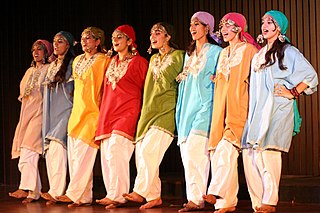Related Research Articles

Urdu is an Indo-Aryan language spoken chiefly in South Asia. It is the national language and lingua franca of Pakistan. In India, where Urdu arose, it is an Eighth Schedule language, the status and cultural heritage of which are recognised by the Constitution of India. It also has an official status in several Indian states.

Languages spoken in the Republic of India belong to several language families, the major ones being the Indo-Aryan languages spoken by 78.05% of Indians and the Dravidian languages spoken by 19.64% of Indians; both families together are sometimes known as Indic languages. Languages spoken by the remaining 2.31% of the population belong to the Austroasiatic, Sino–Tibetan, Tai–Kadai, and a few other minor language families and isolates. According to the People's Linguistic Survey of India, India has the second highest number of languages (780), after Papua New Guinea (840). Ethnologue lists a lower number of 456.

Kashmiri or Koshur is a Dardic Indo-Aryan language spoken by around 7 million Kashmiris of the Kashmir region, primarily in the Kashmir Valley and Chenab Valley of the Indian-administrated union territory of Jammu and Kashmir, over half the population of that territory. Kashmiri has split ergativity and the unusual verb-second word order.

Baramulla district or Varmul is one of the 20 districts in the Indian-administered union territory of Jammu and Kashmir (J&K) in the disputed Kashmir region. Baramulla town is the administrative headquarters of this district. The district covered an area of 4,588 km2 (1,771 sq mi) in 2001, but it was reduced to 4,243 km2 (1,638 sq mi) at the time of 2011 census. In 2016, the district administration said that the area was 4,190 km2 (1,620 sq mi). Muslims constitute about 98% of the population.

Kashmiris are an Indo-Aryan ethnolinguistic group speaking the Kashmiri language and originating from the Kashmir Valley, which is today located in Indian-administered Jammu and Kashmir.

The official religion of Pakistan is Islam, as enshrined by Article 2 of the Constitution, and is practised by an overwhelming majority of 96.35% of the country's population. The remaining 3.65% practice Hinduism, Christianity, Ahmadiyya, Sikhism, Zoroastrianism and other religions.

Doiwala is a town and a Nagar Palika in Dehradun district in the state of Uttarakhand, India.

Indian Sikhs number approximately 21 million people and account for 1.7% of India's population as of 2011, forming the country's fourth-largest religious group. The majority of the nation's Sikhs live in the northern state of Punjab, which is the only Sikh-majority administrative division in the world.

Kashmiri Muslims are ethnic Kashmiris who practice Islam and are native to the Kashmir Valley of Indian-administered Jammu and Kashmir. The majority of Kashmiri Muslims are Sunni, while Shias form a minority. They refer to themselves as "Koshur" in the Kashmiri language.
This is a list of States and Union Territories of India by Bengali speakers at the time of the 2011 Census.
As per Government of India census data of 2011, the total number of Urdu speakers in the Republic of India were 62,772,631. According to the census guidelines, "Urdu" does not broadly refer to the Hindustani language, but the literary-register of the macrolanguage, hence accounting Hindi as a separate language.
The 2001 census of India was the 14th in a series of censuses held in India every decade since 1871.

The 2011 census of India or the 15th Indian census was conducted in two phases, house listing and population enumeration. The House listing phase began on 1 April 2010 and involved the collection of information about all buildings. Information for National Population Register (NPR) was also collected in the first phase, which will be used to issue a 12-digit unique identification number to all registered Indian residents by Unique Identification Authority of India. The second population enumeration phase was conducted between 9 and 28 February 2011. Census has been conducted in India since 1872 and 2011 marks the first time biometric information was collected. According to the provisional reports released on 31 March 2011, the Indian population increased to 1.21 billion with a decadal growth of 17.70%. Adult literacy rate increased to 74.04% with a decadal growth of 9.21%. The motto of the census was Our Census, Our Future.
The Kashmiri diaspora refers to Kashmiris who have migrated out of the Kashmir into other areas and countries, and their descendants.
The Bengali Hindu diaspora is the worldwide population of the Bengali Hindus of Indian and Bangladeshi origin.
The 1951 census of India was the ninth in a series of censuses held in India every decade since 1872. It was also the first census after independence and Partition of India. 1951 census was also the first census to be conducted under 1948 Census of India Act. The first census of the Indian Republic began on February 10, 1951.
An illegal immigrant in India is a foreigner who has entered India either without valid documents or who initially had a valid document, but has overstayed beyond the permitted time, as per the general provisions of the Citizenship Act as amended in 2003. Such persons are not eligible for citizenship by registration or naturalisation. They are also liable to be imprisoned for 2–8 years and fined.

Jammu and Kashmir is a region administered by India as a union territory and consists of the southern portion of the larger Kashmir region, which has been the subject of a dispute between India and Pakistan since 1947 and between India and China since 1959. The Line of Control separates Jammu and Kashmir from the Pakistani-administered territories of Azad Kashmir and Gilgit-Baltistan in the west and north. It lies to the north of the Indian states of Himachal Pradesh and Punjab and to the west of Ladakh which is administered by India as a union territory.
The population of Assam consist of tribal ethnic groups and linguistic groups such as Assamese, Bengali, Hindi speakers, Nepali and Odia speakers.

Brokpa, Drokpa, Dard and Shin is a category of Scheduled Tribes under the Indian constitution.
References
- 1 2 Vijayanunni, M. (26–29 August 1998). "Planning for the 2001 Census of India based on the 1991 Census" (PDF). 18th Population Census Conference. Honolulu, Hawaii, US: Association of National Census and Statistics Directors of America, Asia, and the Pacific. Archived from the original (PDF) on 19 November 2008. Retrieved 17 December 2014.
- ↑ Dev, Amiya (2010). "Literary Multilingualism II : Multilingualism in India". In Lisa Block de Behar; Paola Mildonian; Jean-Michel Djian; Djlel Kadir; Alfons Knauth; Dolores Romero Lopez; Marcio Orlando Seligmann-Silva (eds.). Comparative Literature : Sharing Knowledges for Preserving Cultural Diversity (PDF). Encyclopedia of Life Support Systems. Vol. 2. pp. 172–183. Developed under the Auspices of the UNESCO, EOLSS Publishers, Paris, France, . Retrieved 17 December 2014.
- ↑ "With current trends, it will take 220 years for India's Hindu population to equal Muslims numbers in the world". 16 December 2014.
- ↑ Mallikarjun, B. (7 November 2001). "Languages of India according to 2001 Census". Languages in India. Retrieved 17 December 2014.
- ↑ "Where are the Sanskrit speakers?". The Hindu. 9 August 2014.
- ↑ "Census findings point to decade of rural distress". The Hindu. 25 September 2011.
- ↑ Sugden, Joanna; Seervai, Shanoor (9 January 2015). "Where Are India's 2011 Census Figures on Religion?". Wall Street Journal.
- ↑ "Religion Census: A faithful count".
- ↑ "Muslims' growth rate much lower". The Times of India. 7 September 2004.